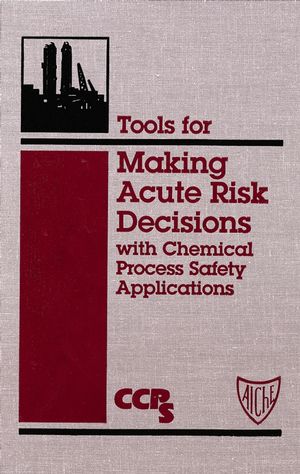Tools for Making Acute Risk Decisions: With Chemical Process Safety ApplicationsISBN: 978-0-8169-0557-7
Hardcover
472 pages
August 1994
 This is a Print-on-Demand title. It will be printed specifically to fill your order. Please allow an additional 15-20 days delivery time. The book is not returnable.
|
||||||
Acronyms.
Chapter 1. Introduction.
1.1. The Challenge of Acute Risk Decision Making.
1.2. Some Key Terms.
1.3. The Basic Risk Decision Process.
1.4. Issues in Selecting a Decision Aid.
1.5. References.
Chapter 2. Key Concepts.
2.1. Purpose of Chapter.
2.2. Economic Evaluation Principles.
2.3. Decision Rules.
2.4. Externalities.
2.5. Value of Life.
2.6. Uncertainty.
2.7. Risk Analysis.
2.8. References.
Chapter 3. Classification and Description of Recognized Decision Aids.
3.1. Purpose of Chapter.
3.2. Descriptions of Recognized Decision Aids.
3.3. Rationale for Choosing Decision Aids To Be Treated in Detail.
3.4. A Word about Decision Aids Based on the Theory of Fuzzy Sets.
3.5. Summary.
3.6. References.
Chapter 4. Evaluating and Selecting Decision Aids.
4.1. Purpose of Chapter.
4.2. Selecting Decision Aids.
4.3. Describe the Problem.
4.4. Identify the Distinguishing Aspects of the Problem.
4.5. Decision Aid Characteristics.
4.6. Decision Aid Characterizations.
4.7. Identify the Problem Class and Candidate Decision Aids.
4.8. Select the Decision Aid(s).
4.9. Summary.
4.10. References.
Chapter 5. Introduction to Case Studies.
5.1. Purpose of Chapter.
5.2. Case One: Underground Pipeline.
5.3. Case Two: Chlorine Rail Tank Car Loading Facility.
5.4. Case Three: Distillation Column.
5.5. A Road Map to the Case Studies.
5.6. References.
Chapter 6. Voting Methods.
6.1. Purpose of Chapter.
6.2. Overview of Voting Methods.
6.3. Explanation of Voting Methods.
6.4. Case Study: Underground Pipeline.
6.5. Extensions of Voting Methods.
6.6. Implementation Needs.
6.7. Summary.
6.8. References.
Chapter 7. Weighted Scoring Methods.
7.1. Purpose of Chapter.
7.2. Overview of Weighted Scoring Methods.
7.3. Explanation of Weighted Scoring Methods.
7.4. Case Study: Distillation Column.
7.5. Extensions of Weighted Scoring Methods.
7.6. Implementation Needs.
7.7. Summary.
7.8. References.
Chapter 8. Cost-Benefit Analysis.
8.1. Purpose of Chapter.
8.2. Overview of Cost-Benefit Analysis.
8.3. Explanation of Cost-Benefit Analysis.
8.4. Case Study: Chlorine Lading Facility.
8.5. Extensions of Cost-Benefit Analysis.
8.6. Implementation Needs.
8.7. Summary.
8.8. References.
Chapter 9. Mathematical Programming.
9.1. Purpose of Chapter.
9.2. Overview of Mathematical Programming.
9.3. Explanation of Mathematical Programming.
9.4. case Study: Underground Pipeline.
9.5. Extensions of Mathematical Programming.
9.6. Implementation Needs.
9.7. Summary.
9.8. References.
Chapter 10. Payoff Matrix Analysis.
10.1. Purpose of Chapter.
10.2. Overview of Payoff Matrix Analysis.
10.3. Explanation of Payoff Matrix Analysis.
10.4. Case Study: Chlorine Loading Facility.
10.5. Extensions.
10.6. Implementation Needs.
10.7. Summary.
10.8. References.
Chapter 11. Decision Analysis.
11.1. Purpose of Chapter.
11.2. Overview of Decision Analysis.
11.3. Explanation of Decision Analysis.
11.4. Case Study: Underground Pipeline.
11.5. Extensions of Decision Analysis.
11.6. Implementation Needs.
11.7. Summary.
11.8. References.
Chapter 12. Multiattribute Utility Analysis.
12.1. Purpose of Chapter.
12.2. Overview of Multiattribute Utility Analysis.
12.3. Explanation of Multiattribute Utility Analysis.
12.4. Case Study: Distillation Column.
12.5. Extensions of Multiattribute Utility Analysis.
12.6. Implementation Needs.
12.7. Summary.
12.8. References.
Chapter 13. review of Case Studies.
13.1. Purpose of Chapter.
13.2. Case One: Underground Pipeline.
13.3. Case Two: Chlorine Rail Tank Car Loading Facility.
13.4. Case Three: Distillation Column.
Chapter 14. Implementing Improvements in Risk Decision Making.
14.1. Purpose of Chapter.
14.2. Keys to Implementation.
14.3. Summary.
Chapter 15. Future Developments.
15.1. Purpose of Chapter.
15.2. The Field of Research on Decision making.
15.3. Specific Areas of Research.
15.4. References.
Appendix A. Software.
Appendix B. Training Programs.
Appendix C. Topical Bibliography.
Index.



